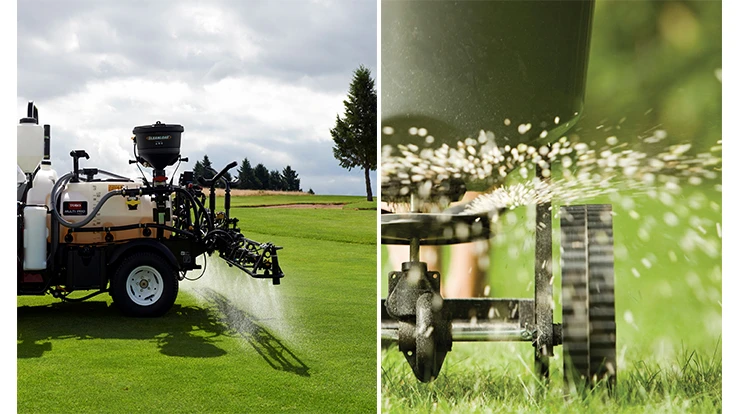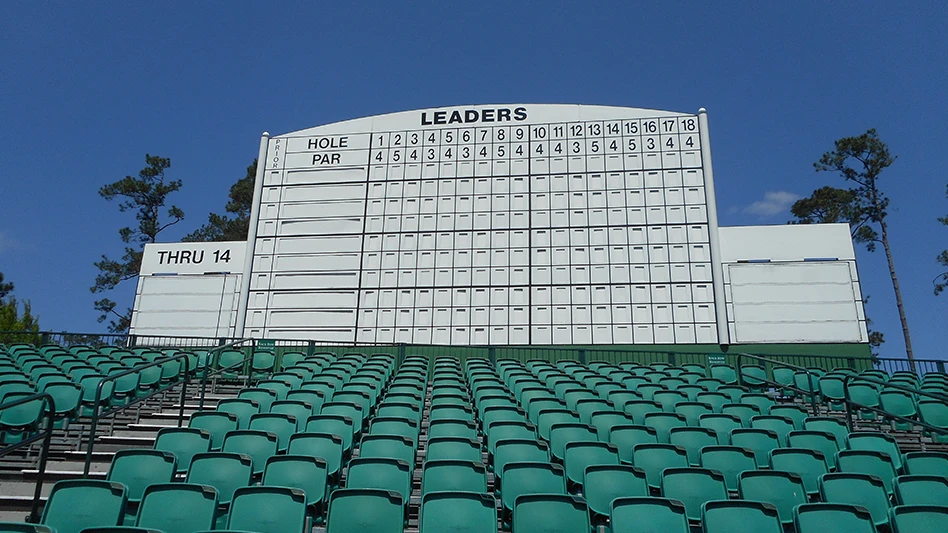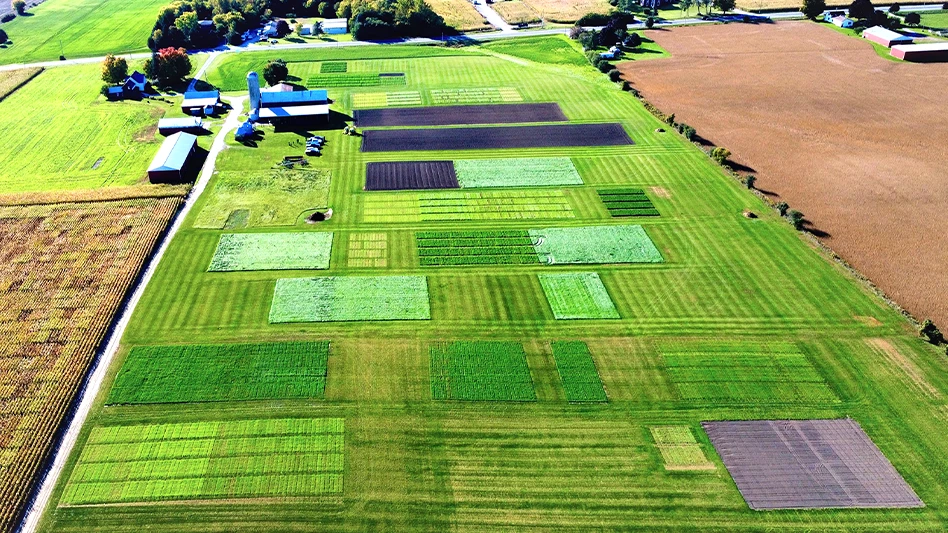
It’s an age-old question in the golf industry: When should superintendents apply a liquid fertilizer, and when should they apply a granular fertilizer?
Superintendents generally apply liquid fertilizers on highly maintained areas and granular fertilizers on lower-maintained areas, and at times when roots could use an extra push. Drawing the line of where and when these factors come into play, however, can become complicated.
Liquid fertilizers often aid root function when roots are not growing at their maximum level, says Dr. Mike Richardson, professor of turfgrass management and physiology at the University of Arkansas. For cool-season grasses, that time is often in the heat of the summer.
Warm-season grasses often benefit from liquid fertilizers heading into dormancy, when they are about a month out from losing their color and ceasing growth, Richardson says. “That would be a good time to consider maybe bumping up your foliar spray just because the leaves are still receptive and can take that nutrient in,” he says.
Generally, superintendents use liquid fertilizers on short-cut and highly maintained turf more than on high-cut turf and out-of-play areas, Richardson says. “I taught a course at GIS on foliar fertilization, and I always survey the participants — they usually have about 100 people in that seminar — to see where they’re putting out foliar nutrients,” he says. “One hundred percent of them use it on the greens, usually about 60, 70 percent of them use them on their tees or fairways, and then just a very small percent, maybe 10 or 15 percent, would use it in more rough or other areas of the course.”
Only a small application of nitrogen, somewhere between two-tenths of a pound and a quarter of a pound per thousand square feet, can be applied as a liquid, Richardson says. At that rate, it would take a lot of time to spray fairways. On greens, however, superintendents regularly spray fungicides, wetting agents and other liquids, so adding liquid fertilizer to the mix is relatively painless.
In pre-conference surveys, Richardson asks superintendents how much of their nitrogen they apply as a foliar to their greens. Usually about 20 to 25 percent of respondents cite a figure somewhere around 75 percent. “I personally think that’s too much,” he says. “I would much prefer that number to be somewhere in the 30 or 40 percent range, and then during the real peak growth period of spring and fall, that they get down some base granular — what I call the foundation of your fertility program — during those seasons, and then supplement that through the other parts of the year with liquid applications.”
Many superintendents choose liquid over granular fertilizer because of uniformity of distribution, says Dr. Larry Murphy, owner of Murphy Agro and consultant for Compass Minerals. “Just by the definition of the material, uniformity of distribution favors liquids, and the application equipment is built to really accommodate this because you’re spraying a liquid,” he says.
Budget can also have an effect on if a superintendent chooses a granular or liquid fertilizer, Murphy says. “Liquids are usually somewhat more expensive than dries, but in turf production that’s not really a big factor because that’s a minuscule part of their overall production costs,” he says.
Granular fertilizers are cheaper and easier to apply than liquid fertilizers, but they have their limitations in certain situations, says Dr. Nick Christians, professor of turfgrass management at Iowa State University. If a superintendents applied a granular fertilizer to a green at a tenth of a pound per thousand square feet, dots would appear all over the surface.
When it comes to plant nutrition, however, there is little distinction to be made between granular and liquid fertilizers, Christians says. “The plant doesn’t care which way it goes,” he says. “It’s going to be the same nutrients. You can successfully apply materials in a liquid form at the same rate as you can at a dry form.”
A great number of factors play into the question of when to use a granular versus a liquid fertilizer, Christians says. Such factors include whether the grass in question is of a warm- or cool-season type, whether it has rained or not and whether the turf has been irrigated or not.
Even within a single area in Iowa, a sand-based green and a soil-based fairway will likely have different requirements, Christians says. “The soil-based fairway you can go at a little higher rate and not do it as often because it’s going to hold the nutrients in place,” he says. “You don’t have as rapid an infiltration rate and so on, and you can very easily do that with a granular spreader. Whereas on the green, you’re probably going to go at a much lighter rate and do it more often, and that’s where liquid applications are very useful.”
As with anything, labor factors play a role, Christians says. “The highest-skilled level of doing this is to apply light rates more often with a liquid application because that takes a lot of skill,” he says. “You’ve got to know how to tank mix, you’ve got to know how to apply the material and it’s more difficult.”
Patrick Williams is a Cleveland-based turf writer and frequent GCI contributor.
Superintendents generally apply liquid fertilizers on highly maintained areas and granular fertilizers on lower-maintained areas, and at times when roots could use an extra push. Drawing the line of where and when these factors come into play, however, can become complicated.
Liquid fertilizers often aid root function when roots are not growing at their maximum level, says Dr. Mike Richardson, professor of turfgrass management and physiology at the University of Arkansas. For cool-season grasses, that time is often in the heat of the summer.
Warm-season grasses often benefit from liquid fertilizers heading into dormancy, when they are about a month out from losing their color and ceasing growth, Richardson says. “That would be a good time to consider maybe bumping up your foliar spray just because the leaves are still receptive and can take that nutrient in,” he says.
Generally, superintendents use liquid fertilizers on short-cut and highly maintained turf more than on high-cut turf and out-of-play areas, Richardson says. “I taught a course at GIS on foliar fertilization, and I always survey the participants — they usually have about 100 people in that seminar — to see where they’re putting out foliar nutrients,” he says. “One hundred percent of them use it on the greens, usually about 60, 70 percent of them use them on their tees or fairways, and then just a very small percent, maybe 10 or 15 percent, would use it in more rough or other areas of the course.”
Only a small application of nitrogen, somewhere between two-tenths of a pound and a quarter of a pound per thousand square feet, can be applied as a liquid, Richardson says. At that rate, it would take a lot of time to spray fairways. On greens, however, superintendents regularly spray fungicides, wetting agents and other liquids, so adding liquid fertilizer to the mix is relatively painless.
In pre-conference surveys, Richardson asks superintendents how much of their nitrogen they apply as a foliar to their greens. Usually about 20 to 25 percent of respondents cite a figure somewhere around 75 percent. “I personally think that’s too much,” he says. “I would much prefer that number to be somewhere in the 30 or 40 percent range, and then during the real peak growth period of spring and fall, that they get down some base granular — what I call the foundation of your fertility program — during those seasons, and then supplement that through the other parts of the year with liquid applications.”
Many superintendents choose liquid over granular fertilizer because of uniformity of distribution, says Dr. Larry Murphy, owner of Murphy Agro and consultant for Compass Minerals. “Just by the definition of the material, uniformity of distribution favors liquids, and the application equipment is built to really accommodate this because you’re spraying a liquid,” he says.
Budget can also have an effect on if a superintendent chooses a granular or liquid fertilizer, Murphy says. “Liquids are usually somewhat more expensive than dries, but in turf production that’s not really a big factor because that’s a minuscule part of their overall production costs,” he says.
Granular fertilizers are cheaper and easier to apply than liquid fertilizers, but they have their limitations in certain situations, says Dr. Nick Christians, professor of turfgrass management at Iowa State University. If a superintendents applied a granular fertilizer to a green at a tenth of a pound per thousand square feet, dots would appear all over the surface.
When it comes to plant nutrition, however, there is little distinction to be made between granular and liquid fertilizers, Christians says. “The plant doesn’t care which way it goes,” he says. “It’s going to be the same nutrients. You can successfully apply materials in a liquid form at the same rate as you can at a dry form.”
A great number of factors play into the question of when to use a granular versus a liquid fertilizer, Christians says. Such factors include whether the grass in question is of a warm- or cool-season type, whether it has rained or not and whether the turf has been irrigated or not.
Even within a single area in Iowa, a sand-based green and a soil-based fairway will likely have different requirements, Christians says. “The soil-based fairway you can go at a little higher rate and not do it as often because it’s going to hold the nutrients in place,” he says. “You don’t have as rapid an infiltration rate and so on, and you can very easily do that with a granular spreader. Whereas on the green, you’re probably going to go at a much lighter rate and do it more often, and that’s where liquid applications are very useful.”
As with anything, labor factors play a role, Christians says. “The highest-skilled level of doing this is to apply light rates more often with a liquid application because that takes a lot of skill,” he says. “You’ve got to know how to tank mix, you’ve got to know how to apply the material and it’s more difficult.”
Patrick Williams is a Cleveland-based turf writer and frequent GCI contributor.
Latest from Golf Course Industry
- GCSAA announces Grassroots Ambassador Leadership Award recipients
- Reel Turf Techs: David Gummo
- PBI-Gordon promotes two to executive level
- VIDEO: A First Green morning
- Bloom Golf Partners adds HR expert
- Seeking sustainability in Vietnam
- Kerns featured in Envu root diseases webinar
- Toro continues support of National Mayor’s Challenge for Water Conservation





